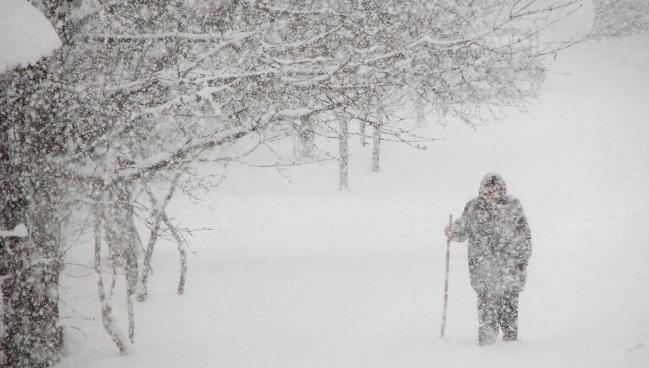Not Just Hot, but Also Cold Weather Extremes Linked to More CV Deaths
More-severe temperatures at both ends of the spectrum raise mortality related to ischemic heart disease, stroke, and HF.

Extreme weather, no matter if it’s hot or cold, puts people at risk of dying from ischemic heart disease, stroke, or heart failure (HF), according to an analysis of patterns seen across the globe.
The study, led by Barrak Alahmad, MD, MPH, PhD (Harvard T.H. Chan School of Public Health, Boston, MA), encompassed data from 567 cities in 27 countries across five continents, for periods between 1979 and 2019. This breadth allowed researchers to look not just at total CV mortality but also deaths from specific types of heart disease.
“Climate change is touching us each and every day, day in and day out,” said study co-author Haitham Khraishah, MD (University of Maryland Medical Center, Baltimore). The changes extend beyond simply warming and include more-severe temperatures. “So we have more ‘hot hot’ days and more ‘cold cold’ days. Although overall we are warming the planet, the extremely cold days are more common than the extremely hot days,” he explained.

What’s “astonishing,” Khraishah told TCTMD, is that “across the board, the relationship was consistent” in showing links between cardiovascular-related death and temperature for the various pathologies. However, HF in particular stood out as being vulnerable to the effects of temperature, especially to heat, which will become an increasingly large concern as the planet grows hotter, he noted. “This is a really important finding moving forward, because heart failure is the number one cost for the inpatient medical system in the US and we need to plan for that accordingly.”
Also noteworthy, he added, is that their observations—published this week in Circulation— were consistent across different climates throughout the world.
“What we need are climate cardiologists,” said Thomas Münzel, MD (University Medical Center Mainz, Johannes Gutenberg University, Germany), who was not involved in the study. “I believe that in 10 years, nobody will talk about cholesterol or hypertension or diabetes, because the major killer will be the environment.”
Climate change is touching us each and every day, day in and day out. Haitham Khraishah
Describing the current study’s data set as “huge,” he agreed it’s important to tease out temperature’s effects in the individual types of cardiovascular disease and learn who is most vulnerable. “For me, it’s not a surprise that people with heart failure are most endangered, because their circulation does not have many resources to compensate for the heat stress” and are on medications that affect fluid balance, he noted.
Moreover, the findings are “beautifully in parallel” with those of another study, published in the Lancet, that estimated 5 million deaths each year worldwide are associated with nonoptimal temperatures, Münzel pointed out.
Heart Failure Most Affected
Alahmad, Khraishah, and colleagues used the Multi-Country Multi-City Collaborative Network, an international research project gathering epidemiological evidence to assess links between weather and health, to create a database of daily CV deaths in each city. Daily temperatures in each city were quantified using weather stations and climate reanalysis models.
They approached the data from two directions. First, they used a case-crossover design wherein each individual serves as their own control, eliminating confounding that might occur due to age, gender, and lifestyle factors. Then, they pooled risk estimates from each of the cities to get an overall perspective.
Data were available for an average of 16 years per country. Regions with temperate climates (eg, Southeastern Asia) had narrow temperature ranges. But most countries showed “considerable variance,” with both cold winters and hot summers. Temperatures fell as low as −30°C in Helsinki, Finland, and reached as high as 44°C in Kuwait City, Kuwait.
In all, there were 32.1 million deaths from any cardiovascular cause. Among those were 11.7 million deaths due to ischemic heart disease, 9.3 million to stroke, 3.7 million to heart failure, and nearly 671,000 due to arrhythmias.
Compared with temperatures at which mortality risk was lowest, extreme heat (99th percentile) was linked to higher risks of ischemic heart disease (RR 1.07; 95% CI 1.04-1.10), stroke (RR 1.10; 95% CI 1.06-1.15), and heart failure (RR 1.12; 95% CI 1.05-1.19). For extreme cold (1st percentile), the associations were even stronger for ischemic heart disease (RR 1.33; 95% CI 1.26-1.41), stroke (RR 1.32; 95% CI 1.26-1.38), and heart failure (RR 1.37; 95% CI 1.28-1.47). For arrhythmias, the data showed more uncertainty and smaller effect size.
In 10 years, nobody will talk about cholesterol or hypertension or diabetes, because the major killer will be the environment. Thomas Münzel
Heat more sharply increased the risk of events, the researchers report, but because the number of cold days exceeded the number of hot, cold weather led to more excess deaths. Hot days that reached above the 97.5th percentile were responsible for 2.2 excess deaths for every 1,000 CV deaths, whereas cold days below the 2.5th percentile contributed 9.1 excess deaths per 1,000. Temperature was most influential for heart failure. Here, the hottest and coldest days carried an extra 2.6 and 12.8 deaths per every 1,000 HF deaths.
“Extreme temperatures from a warming planet may become emerging priorities for public health and preventative cardiology,” the investigators say.
On a population scale, they note, “climate change produces both hotter summers and colder winters, rendering populations not accustomed to these unusual weather conditions vulnerable, especially in low-income areas where there may be less adaptability to changing conditions.” They suggest warning systems triggered by extreme weather could prove helpful.
What’s less clear is how much cardiologists know about these risks and what they can do to lessen them. In their paper, the researchers urge professional societies to take an active role in commissioning scientific statements on the topic of climate and CV health.
Moving forward, it’s necessary to look at which patients are most susceptible to heat and cold, Khraishah said. “We need to identify those individuals, to have policies and recommendations from the medical societies.” Studies must also look at whether different interventions can mediate the risk posed by weather, he added.
Cardiologists in the meantime can encourage their patients to stay aware of weather forecasts and take precautions on especially hot or cold days to limit their exposure by staying indoors and wearing appropriate clothing, Khraishah advised.
Caitlin E. Cox is News Editor of TCTMD and Associate Director, Editorial Content at the Cardiovascular Research Foundation. She produces the…
Read Full BioSources
Alahmad B, Khraishah H, Royé D, et al. Associations between extreme temperatures and cardiovascular cause-specific mortality: results from 27 countries. Circulation. 2022;Epub ahead of print.
Disclosures
- This study was supported by the Kuwait Foundation for the Advancement of Science, US Environmental Protection Agency, Harvard Chan National Institute of Environmental Health Sciences Center for Environmental Health, UK Medical Research Council, UK Natural Environment Research Council, the European Union’s Horizon 2020 Project Exhaustion, the Australian National Health and Medical Research Council, National Institute of Environmental Health Sciences–funded HERCULES Center, MCIN/AEI/10.13039/501100011033, Taiwanese Ministry of Science and Technology, Environmental Restoration and Conservation Agency’s Environment Research and Technology Development Fund, São Paulo Research Foundation, and Fundação para a Ciência e a Tecnlogia.
- Alahmad, Khraishah, and Münzel report no relevant conflicts of interest.





Comments